Nancy: despite the rain, off I went to Napoleon’s Tomb and the 5 Army Museums.
What could be more French than visiting the tomb and other monuments to French war dead? Ann, ever adventuresome, ventured along.
Napoleon’s Tomb and the Army Museums are inside a complex started by Louis XIV, the Sun King, known collectively as “Les Invalides.”
First built was a long narrow church, St-Louis des Invalides, (in the adjacent model, it’s to the left of the big dome) This is where the common soldiers sat. It not being proper to have the monarch mingle near the common folk, Louis XIV then commissioned the Dome Church, where the King and his closest aristocracy attended mass. Surrounding both churches were dwellings for wounded or impoverished soldiers, “the Invalides”, somewhat like a vast American V.A. complex. Today a huge section of Les Invalides comprises five high-class Army Museums.
Napoleon’s tomb is inside the Dome Church. This view is looking at it from the Seine River. The church of St-Louis des Invalides and the Army museum complex are behind the Dome church from this direction.
Once you’re inside the Dome Church, you immediately notice three things: the great gilded altar for King Louis XIV on the first floor, the Baroque dome interior by Mansart, and Napoleon’s Tomb one floor down. In addition to the Tomb, this ground floor has numerous marble panels depicting the Great Man’s accomplishments in reforming the French state and society and those of the European areas he conquered.
- The King’s Altar at the Dome Church
- Inside the Dome, by Mansaart
- Napoleon’s Tomb, on the lower level of the Dome Church
- Napoleon’s Tomb up to Altar
Ann’s reaction: “All this for one man??” That’s likely to be yours, too, unless you are French or know French.
Ann split for the Impressionist art at the Orangerie.
I soldiered on to the main Army Museum, for a special exhibit on “Napoleon versus Europe, 1793-1815.”
This was a splendid multi-media exploration of Napoleon’s military and non-military efforts in conquering Europe, and the many European coalitions that formed and re-formed over a period of 25 years to finally defeated the French. We Americans usually know this end-point as “The Battle of Waterloo.”
The exhibit contained music, such as Beethoven’s Heroic Symphony, dramatic paintings, peace treaties, satirical British political cartoons, uniforms, and numerous volumes of the reformed law code known as the Napoleonic Code. The Napoleonic Code, still in effect in parts of the world today, legally dismantled the old feudal order with its many privileges for the tiny few. One showcase houses replicas of the beautiful jewels Napoleon gave his young Habsburg bride as part of his/their coronation. She rewarded him with a son, adding the possibility of a dynasty.
Napoleon and his troops were often greeted as Liberators by the common people wherever they went. But he took as well as he gave. He wanted to start and populate French museums and promote (natural) science. His troops looted art objects, especially from Italy, and brought exotic animals such as giraffes into France.
- How Napoleon really crossed the Alps to conquer Italy–on a mule
- Napoleon as the great leader, among his wounded soldiers (detail)
- Peace Treaty (Campoformio) showing Napoleon’s signature
- Napoleon’s troops greeted as liberators by the common people of Europe
- New Law Codes that swept away the legal basis of feudalism
- Napoleon crowning himself and his queen, as Pope looks on in horror
- Triumphal Procession of Loot, including exotic animals, into France.
- Napoleon Seizing Italian Art to populate new French museums
In the end, British fortitude, Napoleon’s great military miscalculation with his Russian Invasion, and a rally at the right moment by the Prussians ended Napoleon. He spent the last seven years of his life on a the remote, barren island controlled by the British, St. Helena. His remains were not placed in the Dome Church until 1840, when the “coast was clear.”
Outside the Army Museum, the coast definitely was not clear, as the rain descended even harder.
But greeting me at home was a fine box of yummy macarons. Michael, who had stayed home to deal with a plumbing leak, had gone out between rainstorms to procure these delectables from G. Mulot. Yum!


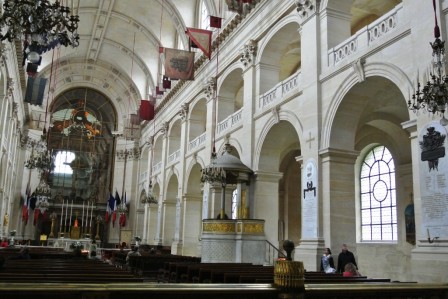

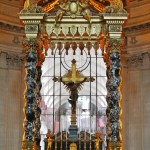



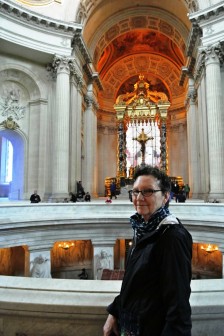
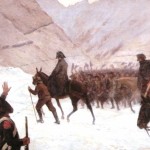


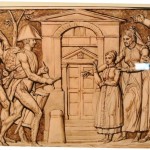


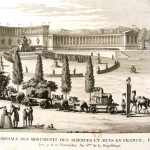
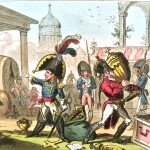
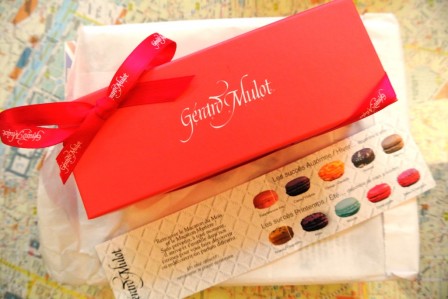
I’m vicariously enjoying your trip to Paris. I’d like to have you as my travel guide.
We’re spending Memorial Day at the Sea Ranch. It’s hard to believe, but it’s kinda raining (just a little). Yesterday’s picnic at One Eyed Jack was fun and very full of people. Some big bucks had a nice salad of poppy flowers in our garden….ate em all. Oh well. We’re going back today but Janelle is coming up late next week and will stay for about 10 days while I go salmon fishing with her brother in Canada. Big hugs, Michael